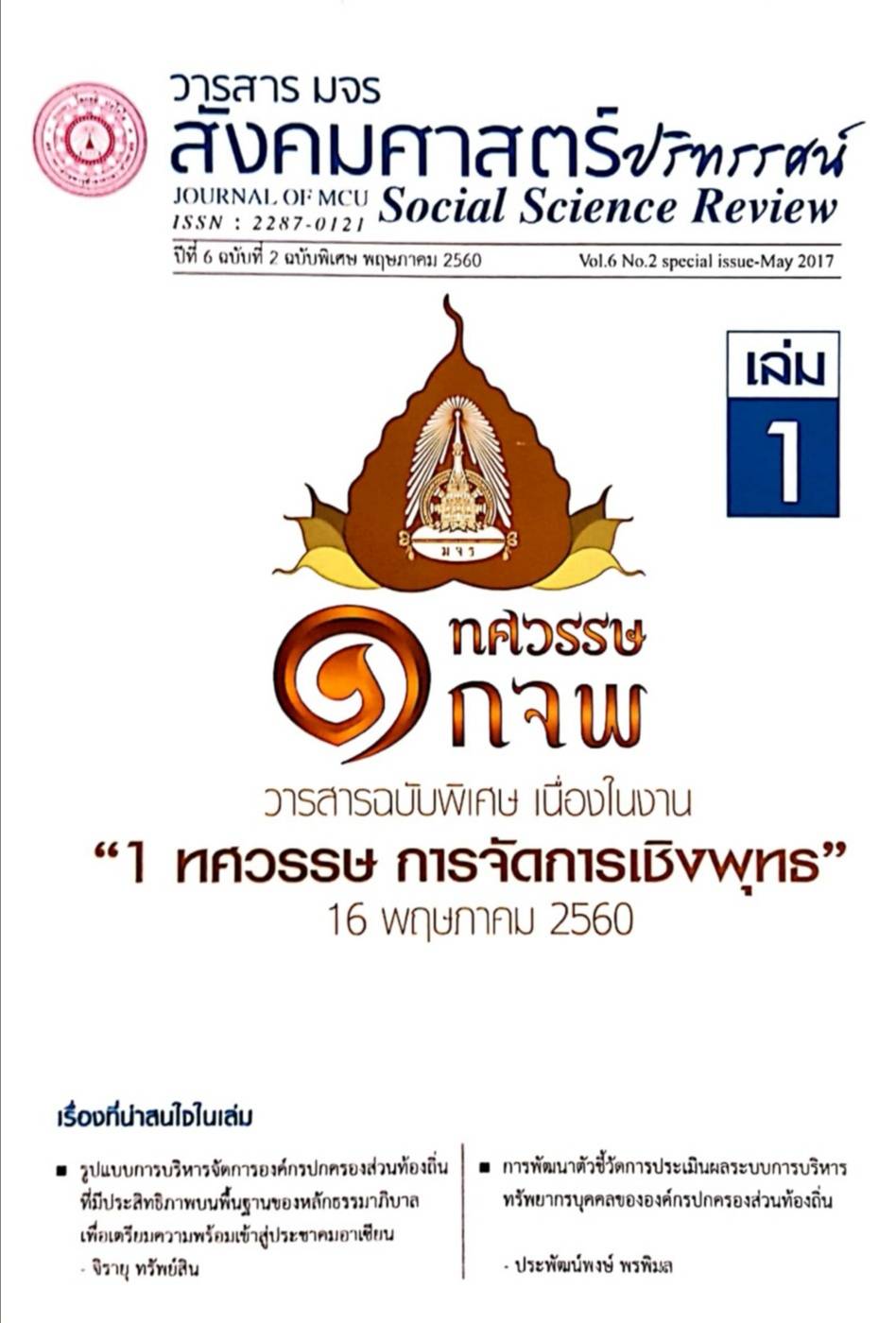การพัฒนาวัดเพื่อเป็นศูนย์กลางการเรียนรู้ของชุมชนในจังหวัดชลบุรี
คำสำคัญ:
การพัฒนาวัด, ศูนย์กลางการเรียนรู้ของชุมชนบทคัดย่อ
การวิจัยฉบับนี้มีวัตถุประสงค์เพื่อ 1) ศึกษาองค์ประกอบในการพัฒนาวัดเพื่อเป็น
ศูนย์กลางการเรียนรู้ของชุมชน 2) ศึกษาสภาพทั่วไปในการพัฒนาวัดเพื่อเป็นศูนย์กลางการเรียนรู้
ของชุมชนในจังหวัดชลบุรี 3) นาเสนอรูปแบบการพัฒนาวัดเพื่อเป็นศูนย์กลางการเรียนรู้ของชุมชน
ในจังหวัดชลบุรี
ระเบียบวิธีวิจัยเป็นแบบผสานวิธี ระหว่างวิธีวิจัยเชิงคุณภาพ จากการวิเคราะห์เอกสาร
และการสัมภาษณ์เชิงลึก จากผู้ให้ข้อมูลสาคัญ จานวน 20 รูปหรือคน วิเคราะห์ข้อมูลโดยการ
วิเคราะห์ข้อมูลเชิงอรรถาธิบายและพรรณนาความ แล้วจึงสร้างรูปแบบเบื้องต้น ก่อนนาเสนอ
ผู้เชี่ยวชาญจานวน 12 รูปหรือคน ยืนยันรูปแบบอีกครั้งหนึ่งในการสนทนากลุ่มเฉพาะ และวิจัยเชิง
ปริมาณ เก็บข้อมูลจากแบบสอบถาม ซึ่งมีค่าความเชื่อมั่นทั้งฉบับเท่ากับ 0.981 จานวน 371 ชุด
กับกลุ่มตัวอย่างคือพระสงฆ์จังหวัดชลบุรี ซึ่งใช้วิธีการสุ่มแบบชั้นภูมิ วิเคราะห์ข้อมูลโดยใช้
โปรแกรมสาเร็จรูปทางสังคมศาสตร์ด้วยคอมพิวเตอร์ สถิติที่ใช้คือค่าความถี่ ค่าร้อยละ ค่าเฉลี่ย
และค่าเบี่ยงเบนมาตรฐาน
ผลการวิจัยพบว่า
1. องค์ประกอบในการพัฒนาวัดเพื่อเป็นศูนย์กลางการเรียนรู้ของชุมชน พบว่า มี 6
องค์ประกอบ คือ (1) เป็นศูนย์การเรียนรู้ชุมชนซึ่งสนับสนุนการศึกษาตลอดชีวิตของบุคคลในชุมชน
โดยการจัดการเรียนรู้และจัดกิจกรรมที่มีความยืดหยุ่นตามความต้องการของประชาชน (2) มี
กิจกรรมที่นาไปสู่กระบวนการคิดเพื่อการแกไขปัญหา โดยการจัดกิจกรรมที่ส่งเสริมและสนับสนุนให้
ชุมชนสามารถแกไขปัญหาความขัดแย้งและความเดือดร้อนโดยการเรียนรู้และร่วมกันแสวงหา
คาตอบของปัญหาที่เกิดขึ้น (3) มีการให้บริการที่ส่งเสริมและพัฒนาการเรียนรู้สารสนเทศให้แก่
ประชาชน โดยการจัดกิจกรรมที่ช่วยส่งเสริมและพัฒนาการรูสารสนเทศให้แกประชาชนที่มารับ
บริการ (4) เป็นแหล่งการเรียนรู้เกี่ยวกับศิลปะจารีตประเพณีวัฒนธรรมและภูมิปัญญาของชุมชน
โดยการจัดศูนย์การเรียนรู้ชุมชนที่มีเอกลักษณ์ประจาท้องถิ่น (5) เป็นศูนย์การเรียนรู้ชุมชนที่มีความ รื่นรมย์ โดยปรับภูมิทัศน์ให้สัปปายะ (6) เป็นเครือข่ายแห่งการเรียนรู้และศูนย์การเรียนรู้เสมือนจริง
โดยจัดศูนย์การเรียนรู้ชุมชนที่ส่งเสริมเครือข่ายแห่งการเรียนรู้และพัฒนาเป็นศูนย์การเรียนรู้เสมือน
จริงโดยใช้เทคโนโลยีดิจิตอล โดยเปิดโอกาสให้ประชาชนเข้ารับบริการสืบค้นสารสนเทศโดยผ่าน
เครือ ข่ายอินเตอรเน็ต
2. สภาพทั่วไปในการพัฒนาวัดเพื่อเป็นศูนย์กลางการเรียนรู้ของชุมชนในจังหวัดชลบุรี
พบว่า ในการบริหารจัดการวัด เจ้าอาวาสถือว่ามีบทบาทสาคัญในการพัฒนาวัด จะเห็นได้ว่าใน
ปัจจุบันนั้นงานด้านต่างๆ ของคณะสงฆ์ประกอบด้วย งานด้านการปกครอง งานด้านการศาสนศึกษา
งานด้านการเผยแผ่พระพุทธศาสนา งานด้านการสาธารณูปการ งานด้านการศึกษาสงเคราะห์ และ
งานด้านการสาธารณสงเคราะห์ เป็นต้น เป็นงานที่เจ้าอาวาสทุกรูปจะต้องปฏิบัติ หรือส่งเสริมงาน
ทุกด้านให้ประสบผลสาเร็จมีผลงานเป็นที่ประจักษ์สู่สาธารณชน ผลที่ได้จากการพัฒนาดังกล่าวก็จะ
เกิดประโยชน์ทั้งคณะสงฆ์ และประชาชนในชุมชนอย่างแท้จริง จากการสารวจพบว่า พระสงฆ์ใน
จังหวัดชลบุรี มีความคิดเห็นต่อการบริหารจัดการวัดในจังหวัดชลบุรี 6 ด้าน ในภาพรวมอยู่ในระดับ
มาก โดยมีค่าเฉลี่ยเท่ากับ 3.54 และเมื่อพิจารณาเป็นด้าน พบว่า ด้านการปกครอง ด้านการเผยแผ่
พระพุทธศาสนา และด้านการสาธารณูปการ อยู่ในระดับมาก ส่วนด้านอื่น ๆ อยู่ในระดับปานกลาง
3. รูปแบบการพัฒนาวัดเพื่อเป็นศูนย์กลางการเรียนรู้ของชุมชนในจังหวัดชลบุรี
ประกอบด้วย 6 รูปแบบ คือ รูปแบบที่ 1 จัดแหล่งเรียนรู้ ด้านภูมิปัญญาท้องถิ่น ได้แก่ ส่งเสริมให้
พระภิกษุสามเณรมีการศึกษาที่สูง ส่งเสริมให้พระภิกษุสามเณรมีความประพฤติที่ดีงาม ส่งเสริมให้
ปราชญ์ชาวบ้านได้แสดงศักยภาพ ส่งเสริมให้ปราชญ์ชาวบ้านมีส่วนร่วมในการพัฒนาชุมชน รูปแบบ
ที่ 2 กิจกรรมที่นาไปสู่กระบวนการคิดเพื่อการแก้ไขปัญหา ได้แก่ ส่งเสริมให้พระภิกษุสามเณรและ
ประชาชนพัฒนาตนเองตลอดเวลา พัฒนาตนเองตามหลักศีล สมาธิ และปัญญา จัดตั้งสานักปฏิบัติ
ธรรม จัดอบรมปฏิบัติธรรมสม่าเสมอ ฝึกฝนตนเองเป็นประจา อบรมจิตให้สงบ รูปแบบที่ 3 จัด
แหล่งเรียนรู้ ด้านเทคโนโลยี ได้แก่ พัฒนาสื่อด้านพระพุทธศาสนาและชุมชนออกเผยแผ่ อบรม
พระภิกษุสามเณรและประชาชนในการใช้สื่อที่ถูกต้อง นาองค์ความรู้ด้านพระพุทธศาสนาและองค์
ความรู้ในชุมชนออกเผยแผ่ในรูปแบบที่หลากหลาย รูปแบบที่ 4 จัดแหล่งเรียนรู้ ด้าน
ศิลปวัฒนธรรม ได้แก่ ส่งเสริมให้พระภิกษุสามเณรและประชาชนเข้าใจและร่วมสืบสาน
ศิลปวัฒนธรรมท้องถิ่น จัดกิจกรรมสืบสานศิลปวัฒนธรรมท้องถิ่น ร่วมกิจกรรมด้านพระพุทธศาสนา
จัดกิจกรรมวันสาคัญทางด้านพระพุทธศาสนาเป็นประจาสม่าเสมอ รูปแบบที่ 5 จัดแหล่งเรียนรู้ด้าน
วิถีชุมชน ได้แก่ จัดห้องสมุดชุมชนภายในวัด รวบรวมหนังสือเกี่ยวกับพระพุทธศาสนาและชุมชน จัด
มุมอ่านหนังสือ / ห้องสมุดเคลื่อนที่ จัดพิพิธภัณฑ์ที่สะท้อนวิถีชีวิตของชุมชน รวบรวมสิ่งที่มีค่าของ
ชุมชน อนุรักษ์/รักษาวิถีชีวิตของชุมชน รูปแบบที่ 6 สร้างเครือข่ายแหล่งการเรียนรู้ ได้แก่ วัด
ชุมชน ชาวบ้าน และหน่วยงานราชการประสานงานกันจัดแหล่งการเรียนรู้ภายในวัด ชุมชน วัด
ชาวบ้าน และหน่วยงานราชการประสานงานกันจัดแหล่งการเรียนรู้ในชุมชน
เอกสารอ้างอิง
สานักงานพระพุทธศาสนาแห่งชาติ.
กรมการพัฒนาชุมชน กระทรวงมหาดไทย. (2551).คู่มือศูนย์เรียนรู้ชุมชน ฉบับประชาชน.
กรุงเทพฯ : โรงพิมพ์ สุภัชนิญค์
จุรีพร กาญจนการุณ. (2546). “การนาเสนอแนวทางการพัฒนาและการใช้ประโยชน์แหล่งการ
เรียนรู้ตลอดชีวิตในชุมชนเขตบางขุนเทียน”. ดุษฎีนิพนธ์ปริญญาครุศาสตรดุษฎีบัณฑิต.
สาขาวิชาพัฒนาศึกษา. บัณฑิตวิทยาลัย : จุฬาลงกรณ์มหาวิทยาลัย.
ดารณี รักดี. (2540).“การพัฒนารูปแบบการศึกษาขั้นพื้นฐานเพื่ออาชีพในชุมชนชนบทพึ่งตนเอง”.
ดุษฎีนิพนธ์ปริญญาครุศาสตรดุษฎีบัณฑิต. สาขาวิชาพัฒนาศึกษา. บัณฑิตวิทยาลัย :
จุฬาลงกรณ์มหาวิทยาลัย.
ปาน กิมปี. (2540). “การพัฒนาเครือข่ายการเรียนรู้การศึกษานอกโรงเรียน เพื่อการพึ่งตนเองของ
ชุมชน”. ดุษฎีนิพนธ์ปริญญาครุศาสตรดุษฎีบัณฑิต. สาขาวิชาพัฒนาศึกษา. บัณฑิต
วิทยาลัย : จุฬาลงกรณ์มหาวิทยาลัย,
พระครูไพศาลวัฒนคุณ สมพร ิตปุญฺโ . (ตุลาคม – ธันวาคม 2559). “ประสิทธิผลการจัดการ
งานสาธารณสงเคราะห์ของวัดในจังหวัดปทุมธานี”. วารสาร มจร สังคมศาสตร์
ปริทรรศน์. 5 (3).
พระปลัดวรัญญู อคฺควชิโร ยอดเพ็ชร. (ตุลาคม – ธันวาคม 2559). “การพัฒนาการบริหารจัดการ
วัดให้เป็นศูนย์กลางชุมชนในยุคโลกาภิวัตน์”. วารสาร มจร สังคมศาสตร์ปริทรรศน์.
5 (3).
พระมหาสนธยา ชมพู. (2552). “ยุทธศาสตร์การเผยแผ่ศาสนธรรมในยุคโลกาภิวัตน์ กรณีวัด
พระธรรมกายและวัดหนองป่าพง”. วิทยานิพนธ์รัฐประศาสนศาสตรดุษฎีบัณฑิต.
วิทยาลัยนวัตกรรมการจัดการ. บัณฑิตวิทยาลัย: มหาวิทยาลัยราชภัฏวไลยอลงกรณ์ ใน
พระบรมราชูปถัมภ์.
พระสมุทรวชิรโสภณ โสภณ ธมฺมโสภโณ. (ตุลาคม – ธันวาคม 2559). “การพัฒนาการส่งเสริม
ศิลปวัฒนธรรมของคณะสงฆ์จังหวัดสมุทรสงคราม”. วิทยานิพนธ์พุทธศาสตรดุษฎี
บัณฑิต. วารสาร มจร สังคมศาสตร์ปริทรรศน์.5(3).
อดุลย์ วังศรี. (2546). “การสังเคราะห์งานวิจัยเกี่ยวกับกระบวนการเรียนรู้ ของชุมชนที่ทาให้ชุมชน
เข้มแข็ง :การวิจัยเชิงชาติพันธุ์วรรณาอภิมาณ”. ดุษฎีนิพนธ์ปริญญาครุศาสตรดุษฎี
บัณฑิต. สาขาวิชาพัฒนาศึกษา. บัณฑิตวิทยาลัย : จุฬาลงกรณ์มหาวิทยาลัย,
ดาวน์โหลด
เผยแพร่แล้ว
รูปแบบการอ้างอิง
ฉบับ
ประเภทบทความ
สัญญาอนุญาต
ลิขสิทธิ์ (c) 2020 วารสาร มจร สังคมศาสตร์ปริทรรศน์

อนุญาตภายใต้เงื่อนไข Creative Commons Attribution-NonCommercial-NoDerivatives 4.0 International License.
เพื่อให้เป็นไปตามกฎหมายลิขสิทธิ์ ผู้นิพนธ์ทุกท่านต้องลงลายมือชื่อในแบบฟอร์มใบมอบลิขสิทธิ์บทความให้แก่วารสารฯ พร้อมกับบทความต้นฉบับที่ได้แก้ไขครั้งสุดท้าย นอกจากนี้ ผู้นิพนธ์ทุกท่านต้องยืนยันว่าบทความต้นฉบับที่ส่งมาตีพิมพ์นั้น ได้ส่งมาตีพิมพ์เฉพาะในวารสาร มจร สังคมศาสตร์ปริทรรศน์ เพียงแห่งเดียวเท่านั้น หากมีการใช้ภาพหรือตารางหรือเนื้อหาอื่นๆ ของผู้นิพนธ์อื่นที่ปรากฏในสิ่งตีพิมพ์อื่นมาแล้ว ผู้นิพนธ์ต้องขออนุญาตเจ้าของลิขสิทธิ์ก่อน พร้อมทั้งแสดงหนังสือที่ได้รับการยินยอมต่อบรรณาธิการ ก่อนที่บทความจะได้รับการตีพิมพ์ หากไม่เป็นไปตามข้อกำหนดเบื้องต้น ทางวารสารจะถอดบทความของท่านออกโดยไม่มีข้อยกเว้นใดๆ ทั้งสิ้น





